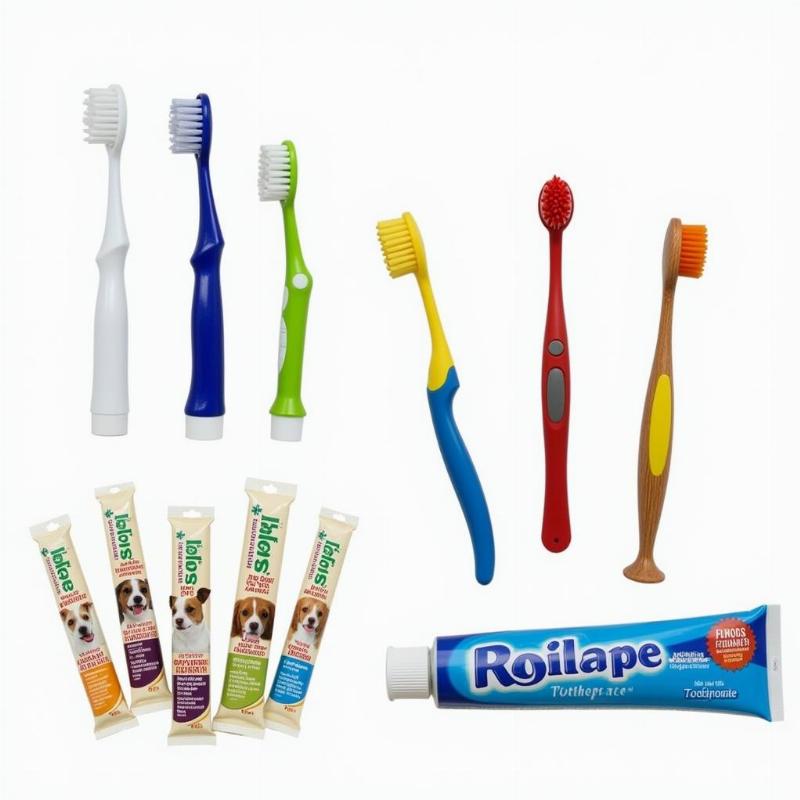Plaque is a common dental problem in dogs, leading to bad breath, gum disease, and even tooth loss. Knowing how to clean plaque off dogs teeth is crucial for maintaining their oral health and overall well-being. This guide provides a comprehensive overview of effective plaque removal techniques, preventative measures, and professional cleaning options available in the US.
Understanding Plaque and Its Impact on Dog’s Health
Plaque is a sticky film that constantly forms on your dog’s teeth. It’s composed of bacteria, food particles, and saliva. If left unaddressed, plaque hardens into tartar, which can only be removed by a veterinarian. Tartar buildup irritates the gums, causing gingivitis, which can progress to periodontitis, a serious infection that damages the supporting structures of the teeth. This can ultimately lead to tooth loss and even systemic health issues in dogs.
Effective Methods for Cleaning Plaque Off Dogs Teeth
Brushing your dog’s teeth regularly is the cornerstone of effective plaque control. Use a dog-specific toothbrush and toothpaste, never human toothpaste, which can be toxic to dogs. Introduce brushing gradually, starting with short sessions and rewarding your dog with praise and treats.
Brushing Techniques and Tips
Hold the brush at a 45-degree angle to the gum line and use gentle, circular motions. Focus on the outer surfaces of the teeth, where plaque accumulates most. Don’t forget the back molars! Aim for daily brushing, but even a few times a week can make a difference.
 Dog Toothbrush and Toothpaste
Dog Toothbrush and Toothpaste
Dental Chews and Treats
Dental chews and treats can be a helpful supplement to brushing, especially for dogs who resist brushing. Look for products approved by the Veterinary Oral Health Council (VOHC), which have been proven to effectively reduce plaque and tartar buildup.
Professional Dental Cleaning for Dogs
While at-home care is essential, professional dental cleaning by a veterinarian is recommended annually or as needed. This involves a thorough cleaning under general anesthesia, which allows for the removal of tartar below the gum line and assessment of overall oral health.
Preventing Plaque Buildup in Dogs
Besides regular cleaning, a healthy diet plays a crucial role in preventing plaque buildup. Dry kibble can help scrape away plaque, while wet food tends to stick to the teeth. Avoid sugary treats and table scraps, which contribute to plaque formation. Regular veterinary checkups are also essential for early detection and treatment of dental problems.
How Often Should You Clean Your Dog’s Teeth?
Ideally, you should brush your dog’s teeth daily. However, if your dog tolerates it a few times a week is a good starting point. Combine brushing with dental chews and treats for optimal plaque control.
Conclusion
Cleaning plaque off your dog’s teeth is vital for their long-term health and happiness. By implementing a consistent oral hygiene routine, including brushing, dental chews, and regular veterinary checkups, you can help your furry friend maintain a healthy smile and avoid serious dental problems. Remember, preventing plaque is always easier than treating established dental disease. How to clean plaque off dogs teeth effectively is not just a question, but an essential responsibility for every dog owner.
FAQ
- What is the best way to clean plaque off my dog’s teeth? Brushing is the most effective method.
- Can I use human toothpaste on my dog? No, human toothpaste contains ingredients that are toxic to dogs.
- How often should I take my dog for professional dental cleaning? Annually or as recommended by your veterinarian.
- What are the signs of dental disease in dogs? Bad breath, red or swollen gums, difficulty eating, and excessive drooling.
- Are dental chews effective in removing plaque? Yes, VOHC-approved dental chews can help reduce plaque and tartar buildup.
- What kind of toothbrush should I use for my dog? Use a toothbrush designed specifically for dogs, which are softer and smaller than human toothbrushes.
- How can I make teeth brushing a positive experience for my dog? Start slowly, use positive reinforcement, and choose a dog-friendly toothpaste flavor.
Related Articles
- dog dental cleaning before and after
- dog teeth cleaning colorado springs
- best dog food for bad teeth
- dog teeth cleaning las vegas
Beautdogs.us is your trusted source for all things dog-related in the US. We provide expert advice on dog breeds, care, and products, empowering both new and experienced dog owners to provide the best possible care for their furry companions. From understanding specific breed needs to finding the right products and services, Beautdogs.us is your one-stop shop for a happy and healthy dog. Contact us for personalized advice and recommendations at [email protected] or call us at +1 501-555-7529.